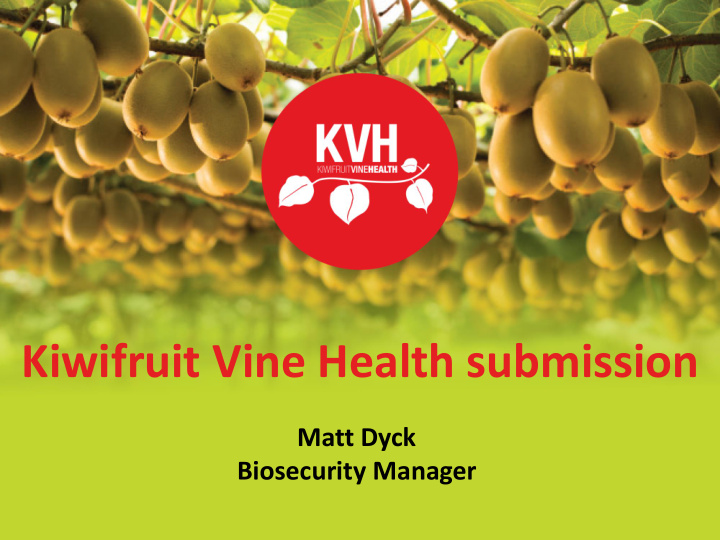



Kiwifruit Vine Health submission Matt Dyck Biosecurity Manager
Kiwifruit Vine Health • Grower funded organisation representing biosecurity interests of kiwifruit & kiwiberry sectors • Est. Nov 2010 to manage Psa incursion • Governed by representatives from New Zealand Kiwifruit Growers Incorporated, ZESPRI, and postharvest organisations
New Zealand kiwifruit industry • Over 2500 growers • Regional importance especially to Bay of Plenty and Eastern Bay of Plenty communities • Māori investment BOP alone >$300m, 2500FTE • Zespri’s goal of doubling global sales of kiwifruit revenue to $4.5b by 2025 • By 2030 (Waikato IBR 2017) • BOP industry employment to 25,000 (↑133 %) • Northland industry employment to 866 (↑133%)
Brown Marmorated Stink Bug • Significant biosecurity threat – very high risk • Major pest of kiwifruit. • Pierces fruit, resulting in fruit drop or subsequent rot • Losses up to 30% on heavily impacted blocks • Impacts both green and gold cultivars
BMSB impacts to Hayward
Chemical control unsuitable • Requires regular and repeat applications of broad spectrum insecticides • BMSB recover within a week • Broad spectrum insecticides result in secondary pest outbreaks • No effective control products available for New Zealand kiwifruit growers • High rates result in residues that not meet both local and export market MRL’s for kiwifruit
Significant research investment • New Zealand • Offshore • And industry specific And many more…
“At the end of the day, this is a landscape scale pest that utilises so many hosts and habitats that there is no possible way that you can hope to manage those populations with insecticides, or traps, or other human tactic. Biological control, especially by the egg parasites, represents the ultimate solution for bringing this pest to economically acceptable levels”. Chris Berg, Professor Entomology, Virginia Tech The male and female Samurai Wasp (Jo Poulton, Plant and Food Research)
Cornell researchers trapping, rearing and releasing wild samurai wasps in New York, as a biocontrol agent on 24 farms in 32 agricultural sites (July, 2018): “ As a biocontrol agent, the wasp is not only very effective at reducing the population of brown marmorated stink bugs, but [it is] the least environmentally damaging of all the options for controlling this pest in both the urban and agricultural system ” Peter Jentsch, Director Hudson Valley Research Laboratory, NY
KVH support the application to release Trissolcus japonicus as a biological control for BMSB, should it arrive and establish in New Zealand Thank you
Recommend
More recommend